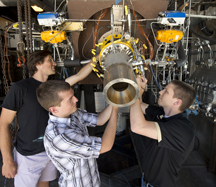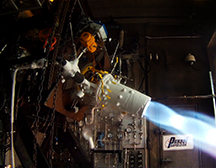Lunar-landing rocket research hits milestone with 'hot-fire' test
August 12, 2014
 |
|
From left, Purdue doctoral students Zach Hallum, Michael Bedard and Eric Meier have worked on a team to design, build and test part of a new rocket engine for a spacecraft to land on the moon, Mars and asteroids. (Purdue University photo/Mark Simons) |
WEST LAFAYETTE, Ind. – A Purdue University student team has designed, built and tested a critical part of a new a rocket engine as part of a NASA project to develop spacecraft technologies needed to land on the moon, Mars and other cosmic venues.
The students are making a central part of the new engine - called the thrust chamber or combustor - as part of NASA's Project Morpheus. The project aims to develop a prototype vehicle capable of vertical takeoff and landing using an autonomous system, as shown in this NASA video: http://www.youtube.com/watch?v=1M5qS0Y3tDw
Such a system requires a high-performance, lightweight rocket engine, said Michael Bedard, a Purdue propulsion engineer and doctoral student.
The Purdue team in May conducted its first "hot-fire" test of the rocket, which uses liquid oxygen and liquid methane propellants. The rocket's thrust chamber was designed, built and tested using specialized facilities at Purdue's Maurice J. Zucrow Laboratories.
Research findings are detailed in a paper being presented during the International Astronautical Congress from Sept. 29 to Oct. 3 in Toronto.
The work began as a senior design project in 2010, initiated by students in a propulsion course taught by William Anderson, a professor in Purdue's School of Aeronautics and Astronautics.
"The students worked amazingly hard on this and were committed to finishing it," Anderson said. "It was a pretty remarkable feat."
Students not only developed the engine's thrust chamber, but also a system to liquefy methane from methane gas.
 |
|
Purdue students have conducted the first "hot-fire" test of the rocket, which uses liquid oxygen and liquid methane propellants. The students have designed, built and tested a central part of the new engine - called the thrust chamber or combustor - as part of NASA's Project Morpheus. (Purdue University photo/Maurice J. Zucrow Laboratories) |
"By liquefying our own methane, we reduced the propellant cost and challenges in transporting the propellant," said Bedard, who led efforts to continue the work after completing the senior design project.
The research paper was authored by Bedard, Anderson, and graduate students Eric Meier and William Hallum.
The eventual goal of the project is to build a lightweight thrust chamber, which requires a thin-walled combustor. Having a thin wall makes it essential to properly cool all of the chamber surfaces, particularly portions that heat up the most. The recent test focused on measuring the "temperature profile" of the thrust chamber wall.
"Propellants burning in the chamber result in extreme temperatures along the chamber walls," Bedard said. "To cool the chamber effectively we need to know exactly where the cooling must be applied. Temperatures inside the combustor can approach 5,000 degrees Fahrenheit. The engine has to run for about two minutes at a time, so keeping the walls cool is critical. The data we are getting from these tests will help us design an optimized cooling approach.”
Also involved in the project were students Thomas Feldman, Andrew Rettenmaier, Brittany Fey, Pamela Slaughter, Isaac Statnekov, Emma McKinney, David Hailey and Ryan Tatro, all of whom have graduated and are now working in the rocket industry.
Information about the project is available at the Purdue Propulsion YouTube Channel: https://www.youtube.com/channel/UCKTsJ2xOCw1Ks2VzjCLgkNQ
Writer: Emil Venere, 765-494-4709, venere@purdue.edu
Sources: Michael Bedard, 508-692-8579, mbedard@purdue.edu
William Anderson, 765-496-2658, wanderso@purdue.edu
ABSTRACT
Temperature profile for liquid oxygen-methane thrust chamber
Michael Bedard, William Anderson, Eric Meier, and William Hallum
Purdue University
In partnership with NASA Johnson Space Center (JSC), a throttleable liquid oxygen/liquid methane thrust chamber was designed, built, and tested by a group of Purdue University students for use in a planetary lander. JSC provided a short list of project requirements and participated in design reviews and discussions. The engine was designed to throttle over a range of 4,200 lbf down to 1,300 lbf. A fixed geometry pintle was chosen as the injector. Testing of a development engine was performed to collect temperature and performance data for use in the design refinement of a flight-weight engine. The basic top-level design requirements for the project provided by JSC are given below.

